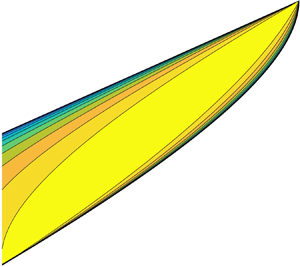Published online by Cambridge University Press: 14 April 2021

In this paper, we study inertial and gravity wave transmissions near radiative–convective boundaries on the f-plane. Two configurations have been considered: waves propagate from the convective layer to the radiative stratified stable layer, or the other way around. It has been found that waves prefer to survive at low latitudes when the stable layer is strongly stratified ( $N^2/(2\varOmega )^2>1$). When the stable layer is weakly stratified (
$N^2/(2\varOmega )^2>1$). When the stable layer is weakly stratified ( $N^2/(2\varOmega )^2 < 1$), however, waves can survive at any latitude if the meridional wavenumber is large. Then we have discussed transmission ratios for two buoyancy frequency structures: the uniform stratification and the continuously varying stratification. For the uniform stratification, we have found that the transmission is efficient when the rotation is rapid, or when the wave is near the critical colatitude. For the continuously varying stratification, we have discussed the transmission ratio when the square of buoyancy frequency is an algebraic function
$N^2/(2\varOmega )^2 < 1$), however, waves can survive at any latitude if the meridional wavenumber is large. Then we have discussed transmission ratios for two buoyancy frequency structures: the uniform stratification and the continuously varying stratification. For the uniform stratification, we have found that the transmission is efficient when the rotation is rapid, or when the wave is near the critical colatitude. For the continuously varying stratification, we have discussed the transmission ratio when the square of buoyancy frequency is an algebraic function  $N^2\propto z^{\nu } (\nu >0)$. We have found that the transmission can be efficient when the rotation is rapid, or when the wave is near the critical colatitude, or when the thickness of the stratification layer is far greater than the horizontal wavelength. The transmission ratio does not depend on the configurations (radiative layer sits above convective layer, or vice versa; wave propagates outward or inward), but only on characteristics of the wave (frequency and wavenumber) and the fluid (degree of stratification).
$N^2\propto z^{\nu } (\nu >0)$. We have found that the transmission can be efficient when the rotation is rapid, or when the wave is near the critical colatitude, or when the thickness of the stratification layer is far greater than the horizontal wavelength. The transmission ratio does not depend on the configurations (radiative layer sits above convective layer, or vice versa; wave propagates outward or inward), but only on characteristics of the wave (frequency and wavenumber) and the fluid (degree of stratification).